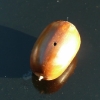How to recognise it
The weevil is a small (4 to 9mm long), brown, beetle-like creature with a long snout called a ‘rostrum’ (the females have longer snouts). You may not spot the adults in the summer, but you may find the larvae inside young nuts or spot small round holes in mature nut fruits.
Lifecycle
Adult females feed on buds and leaves and then lay their eggs in young nuts from June onwards, using their rostrums to bore into the nuts and deposit the egg. The larvae then feed on the kernels before emerging through neat, round exit holes. The larvae burrow into the ground to overwinter and remain dormant until the following summer at which point they pupate. They emerge as adults the next spring or summer.
Why it’s a problem
The affected nuts will be inedible and will not germinate.
Where you are likely to find it
On hardwood nut bearing trees including oaks, hazels, pecans, hickories and chestnuts.
How to deter it
Good hygiene, particularly clearing fallen nuts, should help to reduce numbers.
How to get rid of it
The problem is rarely severe, but you may be able to control the adult weevils by spraying any you spot on the plant in the summer with a contact insecticide. Biological controls, including nematodes and fungi, are currently being investigated for commercial growers.
Ensure all fallen nuts are cleared so the larvae within them don’t have the opportunity to move into the soil for overwintering.
Is it good for anything?!
No
Other useful information
Nut weevils include the Curculio species Curculio nucum, Curculio glandium, Curculio caryae, Curculio elephas and Curculio occidentalis.





